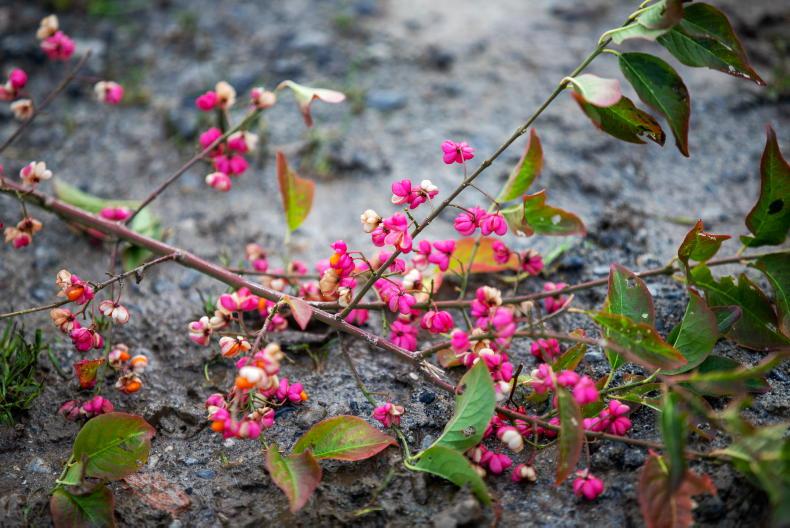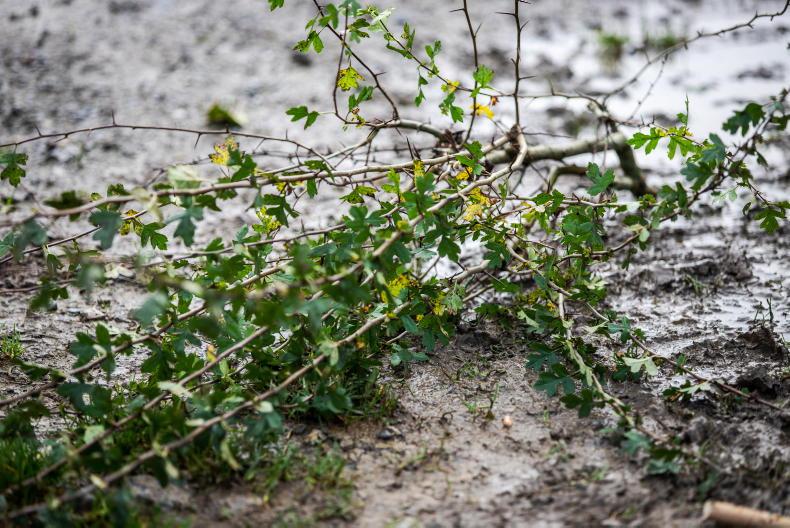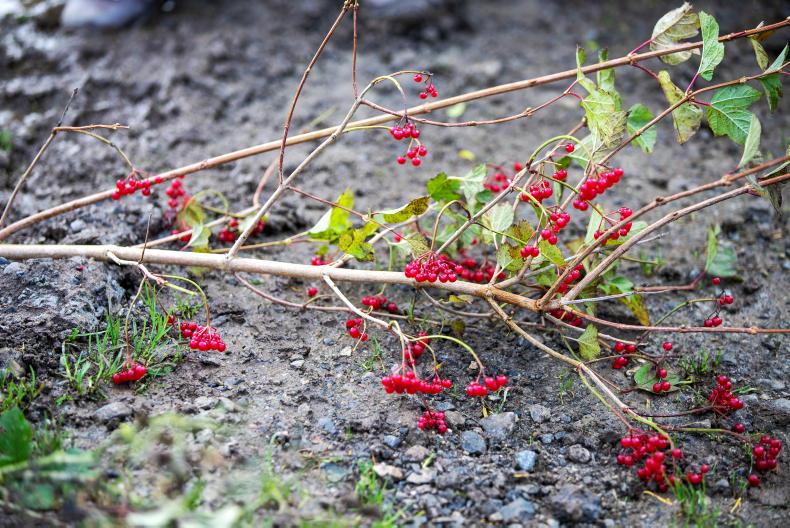As the first frosts of the year approach, the time to plant hedgerows is upon us. The time period for planting as a general rule is from the first frost to 17 March.
A number of the Footprint Farmers have hedgerows to plant and after a training day with Catherine Keena of Teagasc, they are now armed with the basics of planting a good hedge – what to plant, when, where and how.

Catherine Keena talking hedgerows on Tullamore Farm.
However, it should be noted that Catherine recommended farmers to delay planting if rabbits or hares could be an issue. The later it’s left, the closer the hedge will be to the growing season and will escape some of the pests.
What type of hedge do you want?
Do you want a hedge that you top or that you do not top? Do you want a dense hedge or a line of trees or an escaped hedge?
Catherine explained to the group that there should be a mix of different hedgerow types on all farms.

Spindle. \ Claire Nash
Order hedging
There is huge demand for hedgerow plants at present, so order early to ensure you have a supply. Plants will not be available for sale until after the first frost. Bare-root plants are ideal when planting a hedgerow.
Native and Irish-grown plants
Make sure your supplier is growing native plants or sourcing native plants from an Irish grower. Native plants will enhance our natural biodiversity and sourcing locally will avoid bringing pests in from other countries.

Holly.
Some plants like ash or oak can create gaps in the hedge. It is important to consider what type of hedge you want and if you want it to be stock-proof. Catherine advises farmers to plant mainly whitethorn and noted that there is nothing wrong with a pure whitethorn hedge, but it is important to allow a tree to grow up every few metres to provide plenty of flowers for pollinators.

Whitethorn.
1 How many plants per metre?
Six plants are needed per metre.
Five whitethorn and one other (holly, blackthorn, dog rose, etc) should be planted every 2m or so – 550 whitethorns and 50 other plants/100m.
The other plants may be a mixture of different plants suitable to the area. For example, Guelder Rose is suited to wetlands, while Spindle is associated with limestone areas.

Gueldar Rose.
2 How to plant?
Loosen soil with a digger or perhaps a two-furrow plough, where available. Cultivating the soil is essential to get the plant off to a good start.
Plant each stem at 1ft apart in two rows. The plants in the rows should run at a diagonal.
There should also be 1ft between the diagonals (see Figure 1).
3 Clip plants and leave trees
Once planted, the plants should be clipped at 7.5cm (75mm).
Leave an occasional whitethorn plant to grow up as a tree.
Cover this plant with a tree guard.
4 Cover the ground with plastic
Once the row of plants is in and clipped, plastic should be rolled over the area to keep down weeds.
Biodegradable plastic can be purchased or used silage plastic is another option.
The plants should be allowed to break through the plastic. Cut holes where the trees or holly plants are.
The sides of the plastic should then be pressed into the ground with a spade to ensure it stays in place.
5 Fence
Once the hedge is planted, it needs to be protected from stock and animals like rabbits which could damage it. Once the hedge is stock-proof, the fence can be removed.
Low electric fencing can help to keep hares and rabbits away.
Before planting, it’s important to remember that your hedge will eventually be 2-3m in width, so take this into account. It is best to keep back from a laneway or fence, as the hedge will grow into it. The hedge will also have to be cut, so when fencing, leave enough space for a hedge cutter to get in.
6 Why plant hedgerows?
Hedgerows can fence out
stock and provide shelter for
animals on farms.They are not natural habitats, but have huge advantages for biodiversity, creating lines of travel for birds, corridors for animals on the ground, food, shelter and nesting space.They can also sequester carbon and store it, helping to reduce greenhouse gas emissions in the atmosphere.
As the first frosts of the year approach, the time to plant hedgerows is upon us. The time period for planting as a general rule is from the first frost to 17 March.
A number of the Footprint Farmers have hedgerows to plant and after a training day with Catherine Keena of Teagasc, they are now armed with the basics of planting a good hedge – what to plant, when, where and how.

Catherine Keena talking hedgerows on Tullamore Farm.
However, it should be noted that Catherine recommended farmers to delay planting if rabbits or hares could be an issue. The later it’s left, the closer the hedge will be to the growing season and will escape some of the pests.
What type of hedge do you want?
Do you want a hedge that you top or that you do not top? Do you want a dense hedge or a line of trees or an escaped hedge?
Catherine explained to the group that there should be a mix of different hedgerow types on all farms.

Spindle. \ Claire Nash
Order hedging
There is huge demand for hedgerow plants at present, so order early to ensure you have a supply. Plants will not be available for sale until after the first frost. Bare-root plants are ideal when planting a hedgerow.
Native and Irish-grown plants
Make sure your supplier is growing native plants or sourcing native plants from an Irish grower. Native plants will enhance our natural biodiversity and sourcing locally will avoid bringing pests in from other countries.

Holly.
Some plants like ash or oak can create gaps in the hedge. It is important to consider what type of hedge you want and if you want it to be stock-proof. Catherine advises farmers to plant mainly whitethorn and noted that there is nothing wrong with a pure whitethorn hedge, but it is important to allow a tree to grow up every few metres to provide plenty of flowers for pollinators.

Whitethorn.
1 How many plants per metre?
Six plants are needed per metre.
Five whitethorn and one other (holly, blackthorn, dog rose, etc) should be planted every 2m or so – 550 whitethorns and 50 other plants/100m.
The other plants may be a mixture of different plants suitable to the area. For example, Guelder Rose is suited to wetlands, while Spindle is associated with limestone areas.

Gueldar Rose.
2 How to plant?
Loosen soil with a digger or perhaps a two-furrow plough, where available. Cultivating the soil is essential to get the plant off to a good start.
Plant each stem at 1ft apart in two rows. The plants in the rows should run at a diagonal.
There should also be 1ft between the diagonals (see Figure 1).
3 Clip plants and leave trees
Once planted, the plants should be clipped at 7.5cm (75mm).
Leave an occasional whitethorn plant to grow up as a tree.
Cover this plant with a tree guard.
4 Cover the ground with plastic
Once the row of plants is in and clipped, plastic should be rolled over the area to keep down weeds.
Biodegradable plastic can be purchased or used silage plastic is another option.
The plants should be allowed to break through the plastic. Cut holes where the trees or holly plants are.
The sides of the plastic should then be pressed into the ground with a spade to ensure it stays in place.
5 Fence
Once the hedge is planted, it needs to be protected from stock and animals like rabbits which could damage it. Once the hedge is stock-proof, the fence can be removed.
Low electric fencing can help to keep hares and rabbits away.
Before planting, it’s important to remember that your hedge will eventually be 2-3m in width, so take this into account. It is best to keep back from a laneway or fence, as the hedge will grow into it. The hedge will also have to be cut, so when fencing, leave enough space for a hedge cutter to get in.
6 Why plant hedgerows?
Hedgerows can fence out
stock and provide shelter for
animals on farms.They are not natural habitats, but have huge advantages for biodiversity, creating lines of travel for birds, corridors for animals on the ground, food, shelter and nesting space.They can also sequester carbon and store it, helping to reduce greenhouse gas emissions in the atmosphere. 










 This is a subscriber-only article
This is a subscriber-only article










SHARING OPTIONS: